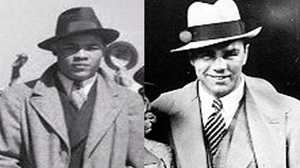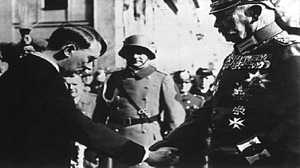Joe Louis in Harlem

"There was never a Harlem like the Harlem of last night. Take a dozen Christmases, a score of New Year's Eves, a bushel of July 4th's and maybe -- yes maybe -- you get a faint glimpse of the idea."— The New York Daily News, June 23, 1938.
When Joe Louis defeated Max Schmeling in a 1938 rematch, the nation celebrated -- and one of the biggest parties was in Harlem. In the famous New York neighborhood, a center of African American culture and home of the cultural flowering known as the Harlem Renaissance, 100,000 people poured out onto the streets. The police commissioner closed off 30 blocks for the revelers. And Harlem added another chapter to its legend, which had begun two decades before.
Black Creative Expression
After the First World War, creative African Americans began to express their unique experiences for a black audience. Their writing and their music, a cultural movement that would become known as the Harlem Renaissance, ultimately found wider, mainstream acclaim. At a time when white culture was celebrating America's emergence as a world power, black Americans had a more balanced view. The "New Negro" writers celebrated American idealism while pointing out the inequalities that were affronts to those same ideals.
A Gathering
The roots of the Harlem Renaissance lay partly in a demographic shift. By the early twentieth century, a large number of Southern blacks had left their birth places for Northern cities, where work was more plentiful. Harlem in Upper Manhattan became a popular destination, and an ideal location for artistic collaboration and performance. Political organizations set up shop in Harlem, including Marcus Garvey's United Negro Improvement Association, W.E.B. Du Bois' National Association for the Advancement of Colored People, and the Urban League. Each of these institutions published regular journals showcasing a new generation of African American poets and essayists.
Common Ground
The common experiences of American blacks, from their recent past and in their struggling present, provided rich literary material to writers like James Weldon Johnson, Countee Cullen, and Jessie Redmond Fausset. Claude McKay's poems The Lynching and To the White Friends defied the accepted racism of the day, and his novel Home to Harlem illustrated African American life in New York City. Langston Hughes wrote poems, novels, plays and an autobiography, all to great acclaim, and earned himself the sobriquet the "Negro Poet Laureate."
Blackface Becomes a Black Face
On stage, "Shuffle Along" (1921) had a record-breaking run and featured work by Eubie Black and Noble Sissle. Two years later the pair created "Chocolate Dandies," featuring the celebrated dancer Josephine Baker. Florence Mills sang and performed in the sort of revues that would have previously starred men in blackface. Actors like Charles Gilpin, Richard Harrison and Paul Robeson starred in African American plays and in black roles in the work of white playwrights like Eugene O'Neill.
In the Clubs and At Home
The music of the era was not new to anyone from New Orleans, but the Apollo Theater, Cotton Club and live radio broadcasts popularized jazz in black and white homes across the nation. Composer/band leader Duke Ellington came up from Washington, D.C., and established a residency at the Cotton Club; regular broadcasts of his shows demanded a constant stream of new compositions, and Ellington and his arranger Billy Strayhorn were up to the task.
White Audiences
White audiences eventually embraced these brilliant artists despite the highly segregated state of American society. Richard Wright's novel Native Son was chosen as a Book of the Month Club selection. Strayhorn's "Take the A Train" celebrated the nightly migration of jazz fans and dancers traveling up to Harlem nightclubs.
Into the Thirties
The Great Depression put a damper on the arts and culture across the nation -- and Harlem was no exception. However, these black luminaries continued to work throughout the 1930s and were joined by writers like Zora Neale Hurston, an anthropologist who drew on her knowledge of American and Caribbean folklore in her books. The Harlem Renaissance gave voice to the black experience and established African Americans as a significant force in American culture.
King Joe
This was the stage set for Joe Louis's 1938 Harlem celebration, and for America's embrace of a black athlete for his strength. For the first time, in the face of the Nazi threat embodied by Schmeling, blacks and whites had rooted for the same guy. On October 1, 1941, a group of musicians recorded "King Joe (Joe Louis Blues)." Jazz pianist and band leader Count Basie wrote the music for the song, novelist Richard Wright wrote the lyrics, and Paul Robeson recorded it, all in celebration of the most famous athlete of the day and a Harlem favorite, Joe Louis.







